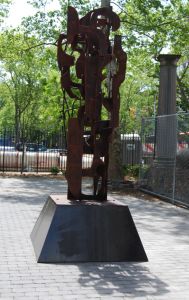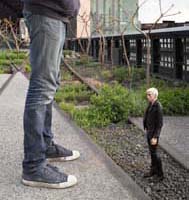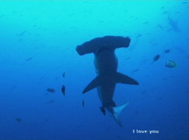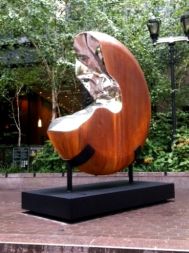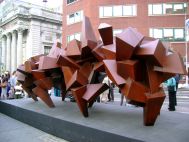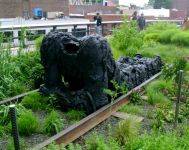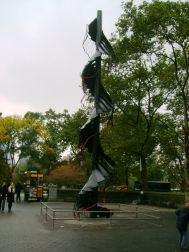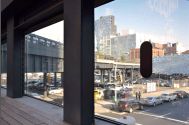Art in the Parks
Through collaborations with a diverse group of arts organizations and artists, Parks brings to the public both experimental and traditional art in many park locations. Please browse our list of current exhibits and our archives of past exhibits below. You can also see past grant opportunities or read more about the Art in the Parks Program.
Public Art Map and Guide
Find out which current exhibits are on display near you, and browse our permanent monument collection.
Search Current and Past Exhibits
2012
Manhattan
Robert Sestok, First Street Iron
April 20, 2012 to April 20, 2013
First Park, Manhattan
Map/Directions (in Google Maps)
Please note: This is a past exhibit that is no longer installed in the park.
Robert Sestok spent most of his career living and working in downtown Detroit, Michigan, which greatly influenced his artistic methods. As part of Detroit’s Cass Corridor arts community, a vibrant movement of artists, musicians, poets and writers during the 60s and 70s, Sestok frequently used found objects and other non-traditional materials, tearing things apart and reconstructing them. This deconstructivist process reflected the reality of the city at the time, and can still be seen today. Though hailing from the Motor City, Sestok frequented New York throughout his life and stated that First Street Iron is “a tribute to my past associations with the city of New York.”
This ten-foot-tall, welded steel sculpture will be placed in the formerly inaccessible property at 33 First Street acquired by New York City’s Parks & Recreation the in 1935. Since 2008, First Street Green (FSG) has worked with Parks Department to revitalize the fallow lot adjacent to First Park—with the goal to remove the rubble and create a plaza and cultural space. The lot was fully renovated with a newly stabilized and paved plaza, landscaping and cast-iron fencing in 2011 when the park hosted the BMW Guggenheim Lab, a three-month temporary pavilion and public forum in which a varied range of cultural activities occurred. During this period 55,000 visitors attended—reinforcing First Street Green’s original observation of a strong need and broad interest in an ongoing cultural space open for public use.
This exhibition is presented by First Street Green.
![]()
Various, Lilliput
April 19, 2012 to April 14, 2013
Throughout the High Line
The High Line, Manhattan
Please note: This is a past exhibit that is no longer installed in the park.
Lilliput will reflect on the traditional role of public art by offering a counterbalance to the monumental scale often employed for plaza sculptures and other outdoor installations in public spaces. As the first project in the HIGH LINE COMMISSIONS series for spring, 2012, Lilliput will feature miniature sculptures installed in unusual and unexpected places at the High Line – amongst the vegetation and along the pathway – to create an art treasure hunt for visitors. Lilliput takes its title from Jonathan Swift’s Gulliver’s Travels, conjuring a magical world populated by fairy tale creatures, mysterious idols, and dreamlike landscapes.
Lilliput will feature installations by six artists from around the globe:
Oliver Laric, Alessandro Pessoli, Tomoaki Suzuki, Francis Upritchard, Erika Verzutti, llyson Vieira
This exhibition is presented by the Friends of the High Line.
![]()
Uri Aran, Untitled (Good & Bad)
April 19, 2012 to April 14, 2013
Between West 25th and West 26th Streets
The High Line, Manhattan
Map/Directions (in Google Maps)
Please note: This is a past exhibit that is no longer installed in the park.
For the High Line, Uri Aran presents a sound work that explores how we use personification and animal metaphors to define human behavior in our daily conversations. Working with a professional voice actor who uses a formal, slightly affected pronunciation, Aran has created a sound track that will emanate softly from the planting beds below the elevated pathway on the High Line between West 25th and West 26th Streets. The sound track features the actor reading a list of creatures, from common ones, like the household cat and the spider, to more wild ones, such the platypus and the shark, each described as “good” or “bad.” Serious and at times comical, the expressionless tone of the actor’s voice will clash with the definition of these creatures as either “good” or “bad,” sparking dialogue about the arbitrary nature of classification in language.
“Uri Aran’s imaginative works have always amazed me,” said Cecilia Alemani, the Donald R. Mullen, Jr. Curator and Director of High Line Art. “I look forward to watching visitors experience this installation and how they react to it as they walk along the High Line.”
This exhibition is presented by the Friends of the High Line.
![]()
Jonathan Prince, G2V
October 2012 to April 2013
Staircase
Dag Hammarskjold Plaza, Manhattan
Map/Directions (in Google Maps)
Please note: This is a past exhibit that is no longer installed in the park.
Interested in evoking archeological artifacts, Jonathan Prince creates sleek sculptural forms with broken edges with his Fragments series. His partial articulation of form allows the audience to participate in the piece, rather than passively view his sculptural work. His 2012 piece, G2V, incorporates exaggerated “broken” edges, creating a dynamic tension with the highly refined form of this stainless steel sculpture.
This exhibition is presented by Cynthia Reeves Projects.
![]()
Malcolm D. MacDougall, Microscopic Landscape
June 14, 2012 to March 31, 2013
Union Square Park, Manhattan
Map/Directions (in Google Maps)
Please note: This is a past exhibit that is no longer installed in the park.
Sharing a natural dialogue with Union Square at the vibrant nexus of New York City is Malcolm D. MacDougall’s sculpture, Microscopic Landscape. The 24 foot, 7,500 lb work “is about potential energy and pushing a stagnant object as close to perceived movement as possible.” The constant motion found in Union Square is a microcosm teeming with diversity that defines the city, finding its inspiration in the multifaceted structures of the sculpture, and in turn inspiring this artist to observe activities as seen on the molecular level. The sculpture serves as a snapshot of the ongoing activity in the neighborhood; it is a static object that maintains the constant anticipation of movement, just as the grounds of Union Square provide the framework for the energetic flow of people and commerce. This exhibition is presented in conjunction with the Union Square Partnership.
![]()
Thomas Houseago, Lying Figure
May 18, 2012 to March 14, 2013
At Little West 12th Street
The High Line, Manhattan
Map/Directions (in Google Maps)
Please note: This is a past exhibit that is no longer installed in the park.
Known for using materials like wood, clay, plaster, steel, and bronze, Houseago creates monumental sculptures that reveal the process of their making through unique details – the varying texture of a molding, the hidden creases within a cast – despite their imposing size and towering forms. His sculptures also incorporate drawing in the form of sketches on plaster and wood panels. Houseago’s work explores abstract lines and figurative forms, and in doing so he joins a long tradition of sculptors that spans from Giacometti to Picasso, engaging viewers with qualities that are at once impressive and enchanting.
For the High Line, Houseago presents Lying Figure, a 15-foot-long bronze sculpture of a headless giant resting on its elbows on the wooden rail ties between the High Line’s original rail tracks. As the third project in the HIGH LINE COMMISSIONS series for spring, 2012, Houseago’s Lying Figure will juxtapose Lilliput, the group exhibition that debuted on Thursday, April 19. Lilliput takes its title from Jonathan Swift’s Gulliver’s Travels, and conjures a magical world populated by fairy tale creatures, mysterious idols, and dreamlike landscapes. Houseago’s Lying Figure will introduce the presence of a giant – the park’s own Gulliver – into Lilliput’s diminutive sculptures installed along the park’s pathway and amidst the plants.
This exhibition is presented by the Friends of the High Line
![]()
Monika Sosnowska, Fir Tree
October 24, 2012 to February 17, 2013
Doris C. Freedman Plaza
Central Park, Manhattan
Map/Directions (in Google Maps)
Please note: This is a past exhibit that is no longer installed in the park.
This 40-foot-tall steel sculpture by Monika Sosnowska marks the threshold between the urban environment of midtown Manhattan and the landscape of Central Park. The artist has used pulleys, cranes, and other heavy machinery to manipulate a spiral staircase to resemble an evergreen tree. No longer climbable, its stairs cascade around the central shaft of the sculpture like weighted tree limbs. The ribbon-like railing forms a twisting red line against the black silhouette of the sculpture. As if piercing the pavement with industrial force, Fir Tree (2012) conjures an image of skyscrapers with steel roots below the city.
For more than ten years, Sosnowska’s work has explored our psychological relationship to the built environment, creating complex installations that alter our perceptions of familiar objects and spaces. Based in Warsaw, Sosnowska often works with architectural elements associated with Eastern Europe during the Soviet period. Fir Tree echoes the industrial steel staircases found on the exterior walls of Polish housing blocks. Here, this once-functional object refuses to serve its intended purpose. Instead it becomes an animated and outsized metaphor, testing the bounds of a familiar form as it reaches toward the urban skyline.
This Exhibition is presented by the Public Art Fund.
![]()
Richard Artschwager, blps
October 25, 2012 to February 3, 2013
Various Locations. Gansevoort Street to West 34th Street, between 10th & 11th Avenues
The High Line, Manhattan
Map/Directions (in Google Maps)
Please note: This is a past exhibit that is no longer installed in the park.
High Line Art and the Whitney Museum of American Art present a series of blps by acclaimed artist Richard Artschwager, in conjunction with the artist’s retrospective Richard Artschwager! at the Whitney. These public interventions consist of black or white lozenge-shaped marks that inspire focused looking, and draw attention to architecture, structures, and surfaces that usually go unnoticed.
![]()
Leo Villareal, Buckyball
October 25, 2012 to February 1, 2013
Madison Square Park, Manhattan
Map/Directions (in Google Maps)
Please note: This is a past exhibit that is no longer installed in the park.
Madison Square Park Conservancy’s Mad. Sq. Art presents a monumental sculpture by acclaimed artist, Leo Villareal. Largely inspired by the work of Buckminster Fuller, Villareal’s BUCKYBALL will apply concepts of geometry and mathematical relationships within a towering 30-foot tall, illuminated sculpture.
A commission of the Mad. Sq. Art program, Villareal’s BUCKYBALL will feature two nested, geodesic sculptural spheres comprised of 180 LED tubes arranged in a series of pentagons and hexagons, known as a “Fullerene,” referring to the form’s discovery by Buckminster Fuller. Individual pixels located every 1.2 inches along the tubes are each capable of displaying 16 million distinct colors and will be specifically tuned by the artist’s own software, creating a subtle and sophisticated palette to enliven the Park. Relying on LED technologies driven by chance, BUCKYBALL’s light sequences will create exuberant, random compositions of varied speed, color, opacity, and scale. BUCKYBALL will trigger neurological processes within the brain, calling on our natural impulse to identify patterns and gather meaning from our external environment.
Through basic elements such as pixels and binary codes, Villareal allows for a better understanding of the underlying structures and systems that govern everyday function. As he builds these simple elements into a full-scale sculptural installation that moves, changes, and interacts, this work ultimately grows into a complex, dynamic form that questions common notions of space, time, and sensorial pleasure.
This exhibition is presented by Mad. Sq. Art.
![]()
Saint Clair Cemin, Saint Clair Cemin on Broadway
September 5, 2012 to January 25, 2013
W. 57th Street to W. 157th Street
Broadway Malls, Manhattan
Map/Directions (in Google Maps)
Please note: This is a past exhibit that is no longer installed in the park.
Spanning 100 blocks to various locations along Broadway, Cemin’s monumental mirrored stainless steel sculpture, Vortex, will tower 40 feet high, embodying mankind’s desire for transcendence, whisking up into the clouds all that it reflects on its surface. Along with six additional Broadway malls, stretching to W. 157th Street, Cemin will present sculptures in a range of material. These sculptures include: The Four, 1997, a Corten steel sculpture that longs to be at once both geometric and organic; In The Center, 2002, an ominous archetypical creature existing at the core of our minds; Portrait of the Word Why, 2008, a mirrored stainless steel portrait of one of the most mysterious words in the English language; Aphrodite, 2006, a copper depiction of the ancient goddess in primitive form, representing the female figure simply and hieratically; and The Wind, 2002, a large white marble sculpture which appears like putty, kneaded and manipulated by giant hands.
This project is presented by The Broadway Mall Association in collaboration with Paul Kasmin Gallery, New York City Department of Parks & Recreation, Department of Transportation and the Lincoln Square Business Improvement District.
![]()
